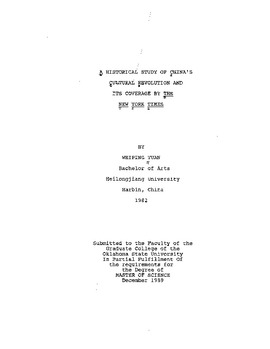| dc.description.abstract | This thesis has generally adopted the Chinese Pinyin System of Romanization for transcribing Chinese names and places. Original spellings of names of persons and places have changed into Pinyin, which has been adopted by The New York Times for many years. For example, Peking is Beijing, Mao Tsetung is Mao Zedong and Liu Shao-ch'i is Liu Shaoqi, Chou Enlai ia Zhou Enlai. The original spelling is found only in quotations. The names of persons in this thesis are spelled in the traditional Chinese way, that is, surname first, except in the case of Nien Cheng, who chose to put her surname last in her book Life and Death in Shanghai. A few names of persons bear a hyphen between a two-word name. Such names were left as they appear in the quotations. Last of all, pinyin represent sounds similar to English sounds with only a few exceptions, such as c in Pinyin equals to ts in English; q equals to ch; x equals to sh; z equals to dz and zh equals to j. | |
